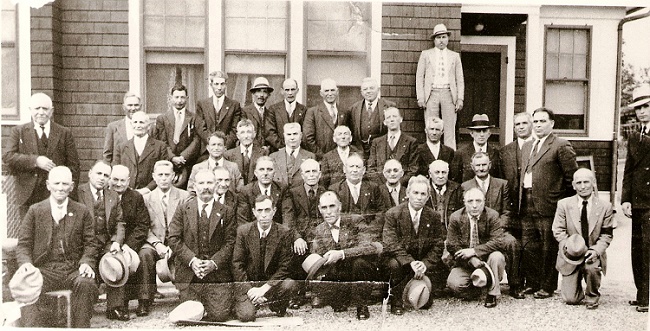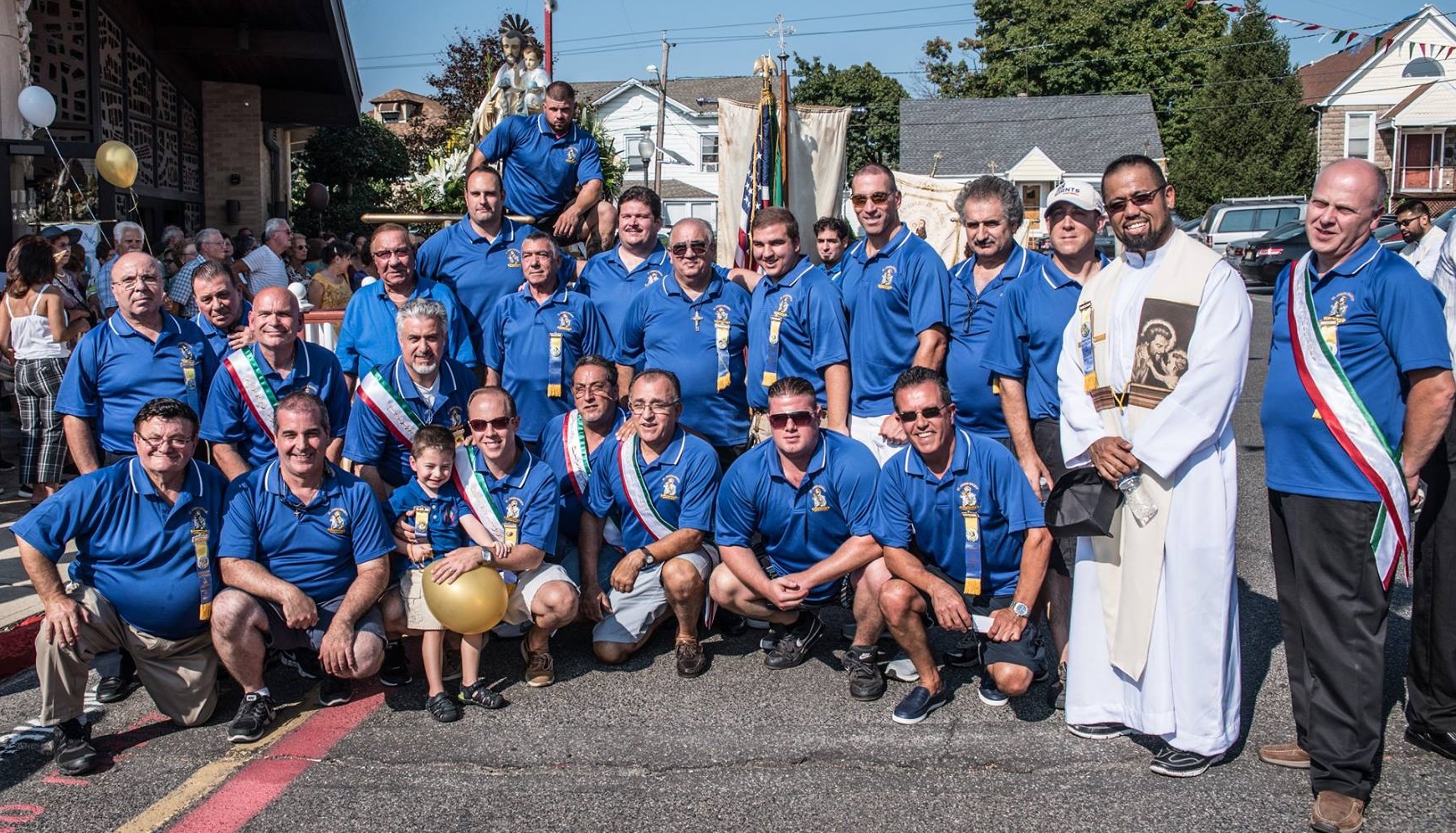

The Saint Joseph Society was officially incorporated on December 7th, 1915 by Italian immigrants from various towns in Sicily. These men were devoted to Saint Joseph. There mission was to have a place of worship in honor of their patron saint to be located in Lodi, New Jersey.

The founding fathers worked together to help build the First Saint Joseph Church in 1917. Each member took out a personal loan to help contribute financially to make their dreams become real. The other amazing thing the members did was that they themselves did the actual work in building the first Saint Joseph's Church. As Saint Joseph was a carpenter during his life on earth, those men played the role of Saint Joseph in helping to construct their house of worship.
In addition to having a house of worship, the society wanted to honor their patron saint in a special way. March 19th is the feast day of Saint Joseph. The society started the tradition here in Lodi, (which was originally founded back home in Sicily) of giving out the "pane di San Giuseppe" (Bread in honor of Saint Joseph) on his Feast day. Being March 19th fall's during the work week most of the time, the society decided it would distribute bread to all parishioners at every mass the weekend closest to March 19th. This tradition still exists today.
Another tradition founded back in Sicily to celebrate the Feast Day of Saint Joseph is "La Tavolata di San Giuseppe" (Saint Joseph sharing table). This tradition was started by the society and later throughout the years passed onto the church to run this event. However, once again in 2008 the Society is hosting this event and looks forward to doing so for many years to come. These were great traditions brought here to America from the old country. However, the members were still not satisfied in just celebrating these two events. They wanted a procession in honor of Saint Joseph and a Feast. Being March is still cold, they looked to September which is warm and celebrates Labor Day. This is a national holiday here in the United States, but the founding fathers had other thoughts. Labor Day is a holiday for all workers. The Italians decided that what better holiday that models the life of Saint Joseph being he was a laborer to host a Feast. So, the idea was born to host a Feast in honor of Saint Joseph during Labor Day Weekend. The Feast activities were to include, rides, games, Italian food specialties and nightly entertainment. The highlight of the Feast would be the procession which would be held on Labor Day in the afternoon followed by a benediction. 105 years later, this is still the case. Although the town has changed in that there are now many different ethnic groups, it is still a large success and well known event in Northern New Jersey.
As part of spreading the word about the Saint Joseph Feast, in the early spring months the members of the society would go house to house in Lodi in asking for donations for the upcoming Feast in September. This tradition lasted until the 1980's. The other word of mouth advertisement was that during the Feast on Saturday, Sunday, and Monday morning, the society accompanied by the Italian Feast band would split out into three groups covering a majority of the streets in Lodi and surrounding towns such as Garfield and Hasbrouck Heights. Each group would go out with a "stenardo" (banner) of Saint Joseph so people can pin money on the flag. Each door bell at every house would be rung and the band would play favorite songs such as "Mamma", "Oh Marie", "Santa Lucia" and etc.
The Saint Joseph society was once a strong group of having close to 100 members during the 1940's to the 1960's. However, as time passed on, so did many of the members pass on to their life in Heaven. During the early years, everything was conducted in the Italian language. This held true until the 1970's at which point it started to change over to English. In addition to how the changes in meetings were conducted, so was the decision made to hand over the majority of the Feast responsibility to the church. Being the membership had rapidly decreased, it would be impossible for the society to run the Feast alone. So the responsibilities of hiring the rides, games, and food would be the church's responsibility. The entertainment would be the society's in addition to the traditions of collections during the Feast weekend and procession.

As we look at the present and future, we pray that through the intercession of Saint Joseph that we will once again become a strong group of members. Today our society consist of 30+ members. The meeting is conducted in both English and Italian to accommodate all members. It is difficult in being able to try to run events such as a society dinner dance, picnic, or other activities without more members. However, we do participate in processions of other local societies such as: Immaculate Conception of Lodi, Saint Anthony of Garfield, Sacred Heart of Garfield, San Pio of Garfield, San Ciro of Garfield, San Pio of Hackensack, the Frainese Society of Clifton,Saint Gerard of Newark, and San Rocco of NYC. We make donations to the needy and contribute funds to our church's Food Pantry for the poor. Our meetings are held usually on a Monday once a month in the church rectory.

St. Joseph, is the foster-father of Jesus and the husband of the Blessed Virgin Mary. Because of his merits, he is known by many titles: Patron of the Universal Church, Patron of the Sick and Dying, Patron of Fathers, Patron of Workers, Scourge of Demons, among many others.
Because not one word of his is recorded in Holy Scriptures, St. Joseph is the silent figure of three persons in the Holy Family. Yet, reading of his God-given tasks and how he reacted to them, proves that St. Joseph, after Jesus Himself, is the greatest man to imitate in your daily life.
Everything we know about the husband of Mary and the foster father of Jesus comes from Scripture and that has seemed too little for those who made up legends about him.
We know he was a carpenter, a working man, for the skeptical Nazarenes ask about Jesus, "Is this not the carpenter's son?" (Matthew 13:55). He wasn't rich for when he took Jesus to the Temple to be circumcised and Mary to be purified he offered the sacrifice of two turtledoves or a pair of pigeons, allowed only for those who could not afford a lamb (Luke 2:24).
Despite his humble work and means, Joseph came from a royal lineage. Luke and Matthew disagree some about the details of Joseph's genealogy but they both mark his descent from David, the greatest king of Israel (Matthew 1:1-16 and Luke 3:23-38). Indeed the angel who first tells Joseph about Jesus greets him as "son of David," a royal title used also for Jesus.
We know Joseph was a compassionate, caring man. When he discovered Mary was pregnant after they had been betrothed, he knew the child was not his but was as yet unaware that she was carrying the Son of God. He planned to divorce Mary according to the law but he was concerned for her suffering and safety. He knew that women accused to adultery could be stoned to death, so he decided to divorce her quietly and not expose her to shame or cruelty (Matthew 1:19-25).
We know Joseph was man of faith, obedient to whatever God asked of him without knowing the outcome. When the angel came to Joseph in a dream and told him the truth about the child Mary was carrying, Joseph immediately and without question or concern for gossip, took Mary as his wife. When the angel came again to tell him that his family was in danger, he immediately left everything he owned, all his family and friends, and fled to a strange country with his young wife and the baby. He waited in Egypt without question until the angel told him it was safe to go back (Matthew 2:13-23).
We know Joseph loved Jesus. His one concern was for the safety of this child entrusted to him. Not only did he leave his home to protect Jesus, but upon his return settled in the obscure town of Nazareth out of fear for his life. When Jesus stayed in the Temple we are told Joseph (along with Mary) searched with great anxiety for three days for him (Luke 2:48). We also know that Joseph treated Jesus as his own son for over and over the people of Nazareth say of Jesus, "Is this not the son of Joseph?" (Luke 4:22)
We know Joseph respected God. He followed God's commands in handling the situation with Mary and going to Jerusalem to have Jesus circumcised and Mary purified after Jesus' birth. We are told that he took his family to Jerusalem every year for Passover, something that could not have been easy for a working man.
Since Joseph does not appear in Jesus' public life, at his death, or resurrection, many historians believe Joseph probably had died before Jesus entered public ministry.
Joseph is the patron of the dying because, assuming he died before Jesus' public life, he died with Jesus and Mary close to him, the way we all would like to leave this earth.
There are two feast days celebrated in the catholic church for Joseph: March 19 for Joseph the Husband of Mary and May 1 for Joseph the Worker.
There is much we wish we could know about Joseph -- where and when he was born, how he spent his days, when and how he died. But Scripture has left us with the most important knowledge: who he was -- "a righteous man" (Matthew 1:18).
Oh dearest St. Joseph, be pleased to accept the consecration which I make to thee of myself. I dedicate myself entirely to thee that thou may ever be my father, my protector, and my guide in the way of salvation. Obtain for me the great purity of heart and a fervent love of the interior life. ' Grant that after thy example all my actions may be directed to the greater glory of God, in union with the divine Heart of Jesus and the Immaculate heart of Mary and with thee. Finally pray for me that I may be able to share in the peace and joy of thy most holy death. Amen.
Questions or comments can be directed to the email address below. Donations can be mailed to the address below in the form of a check payable to the Saint Joseph Society. Thanks!